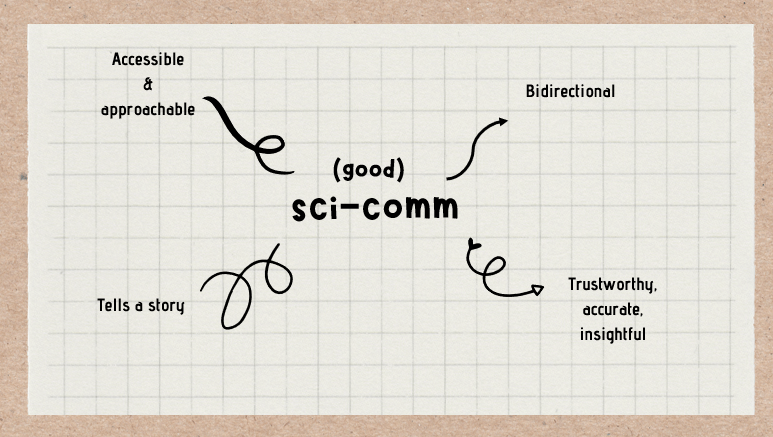
Sci-comm is a word we hear a lot. Most postgrad courses have some built in training, and the Twitterverse dictionary surely cites #scicomm and #outreach as some of the most used words across science communities.
We may all be armchair experts now, but as students, it can be daunting to put yourself out in the world as a so-called ‘scientist’ while we are still learning to be one ourselves.
I hope to change your mind.
Let’s first consider the pillars of good sci comm.

Trustworthy, accurate, insightful. In an era plagued with misinformation, we understand the importance of this all too clearly. As students we may fear that we are (a) not an authority on a subject, and (b) don’t know enough.
But you are an authority, and it takes escaping the academic bubble to understand just how much you know.
Nonetheless, it is guaranteed that you will be asked something you don’t know. This doesn’t mean you weren’t prepared. You can’t know everything, and you cannot predict what sort of wildcard questions could be pulled on you. When this happens, be honest – say you don’t know. Never lie or try to cobble together an answer from half-facts at the back of your mind. Part of our job is to debunk the myth and legend surrounding scientists, and this includes admitting that we don’t know everything. We are not all-knowing gods and should not be seen as such!
But even if our brains are packed were packed with all the knowledge in the world, how on earth do you explain complicated concepts without the abridging power of scientific jargon?
There is no ‘debunk the fear’ answer here, just practice and preparation. If you will be delivering sci-comm in public, always take time to think about it in advance so that you go in feeling comfortable and confident. Get to know the activities, prepare analogies, listen to how others do it and decide what you like and don’t in their explanations. Making things up on the spot under pressure won’t go well. The small comfort is that this is something that researchers of all levels face. Being a senior researcher doesn’t automatically make you a good communicator, and many will admit to still feeling nervous about talking science in public; it’s hard at first, and it just takes practice.
The better news is that I believe students and early career researchers have some advantages when it comes to sci-comm.
Another pillar is to be accessible and approachable.
From our side, the fact that we still understand the point of view of being the ‘learner’ is beneficial. We’re less likely to take base knowledge for granted and have more recently had to untangle things for ourselves so know which explanations work and don’t.
From the audience’s side, we may also be more relatable and approachable than many professors, which helps put people at ease and feel able to ask questions.
Two pillars remain – storytelling and bidirectional.
The longstanding model of sci-comm was that we are there to provide access to information that the audience doesn’t already have and would – from our view – benefit from having. This can be well-intentioned and not necessarily from a place of superiority, but it nonetheless misses some key points.
With the goal of ‘filling a knowledge gap’, we summarise or break down the science for the audience to understand it. But understanding does not equal interest or engagement. Without these other two ingredients, although the knowledge is made accessible, it will be quickly discarded.
This model also forgets that we all have unique beliefs and experiences, so the ‘facts’ may be interpreted differently by different people – and not necessarily in the intended way.
Instead, we are moving towards the dialogue model in which sci-comm is two-way, meaning the audience also have a chance to input and have their ideas thoughtfully considered. In this model, you adapt as you go. You also acknowledge that although there is a primary goal to either educate, entertain, or inspire, the three are entwined and to do any of them well, you must hint at the others.
Storytelling helps here – it turns science into more relatable and entertaining content.
So how do you turn science into a story?

First, plan. Consider your key messages – one or two points that you want your audience to remember or be convinced of after the event/reading finishes. Who are you audience, and what is the main purpose? Keep returning to these questions throughout your writing or presentation.
Now, what is going to engage your audience? Relatability and relevance. This includes explaining the social or historical context, and why it could impact the things we care about. The relatability comes in in the way you tell the story, for example considering the emotions at play in the story – what were the struggles, the moments of breakthrough? Emotions help your audience to connect and therefore enjoy and remember.
Involve the reader as you go. Rather than handing opinions out like sweets, give your audience the information and nudge them to come to conclusions themselves. Sci-comm should be an active rather than passive process for the audience as well as you. Remember to describe the process of discovery rather than just stating the results to bring them on the journey.
Simplify as much as possible. Choose one or two key words that are crucial to the story and explain them clearly from the start – everything else should be said in plain English. The UK government recommends any public documents be written with a reading age of 9, to fit the average reading ability of the UK. This of course can be adjusted for your audience, but never assume a level of base science higher than early high school – you can go into more depth if it’s requested, but starting above people’s heads will alienate them. Always remove any details that are not crucial to understanding your key points – they’re boring and distracting. If your audience feels overwhelmed with information they will disengage, or even worse, feel foolish for getting lost.
Replace the jargon with enriching anecdotes and analogies. Choose one or two and use them throughout the story. Try to come up with your own rather than using clichéd ones.
Aside from the CV-boosting and moral obligations (don’t forget, so much of our work is publicly funded!), zooming out to the bigger picture of your field or science in general once in a while has benefits for you and your work. The looks of surprise, curiosity, or astonishment you will evoke when talking science will remind you of your own enthusiasm for the subject, keeping that morale high when your own research may not be going to plan. You will also never fully understand something until you’re able to explain it to others, so you’ll learn a lot along the way.
You’ve attended all the workshops; you know it’s a good idea – but how do you actually get started? Luckily, sci-comm is an easy world to break into. This is because initiatives and groups are always looking for volunteers, and because those already involved in sci-comm tend to be engaged in several projects. Thanks to this, everything – and everyone – is connected.
Just pick something and try it out. Sci-comm is incredibly diverse in terms of audiences and presentation style so there is something suited to everyone: just consider your skills and interests and try something out as a volunteer. For many, writing is a comfortable ‘risk free’ way to start because you don’t have a live audience in front of you, though seeing the reactions and having a conversation can actually be the most enjoyable part of sci-comm. If you haven’t written anything non-academic before, I recommend starting with a volunteer-led publication (most universities have their own science magazines, for example) to build up some experience in a friendly environment before you try pitching to a professional editorial team.
To do in Cambridge:
To do online:
To write (volunteer-led):
To write (professional but explicitly accept contributions from PhD level researchers):
Once you’ve had a go and learned what type of sci-comm you enjoy, build your skills and experience. Besides time, there are some things you can actively do to improve. As said already, preparing before any face-to-face events gives you confidence and a polished feel to your delivery – think about who your audience will be, and what would be an understandable analogy for them. Maybe there’s some props to help! For example, I find it useful to have a phone charger to hand when talking about neurons because many people understand the role of the insulation on the cable, making myelin easier to explain, with the information or electrical transfer along the cable representing the also-electrical action potentials. You don’t always have to start from scratch when preparing activities. Listen to or shadow more experienced members of your team.
Outside of the specific activity, immerse yourself in good examples of sci-comm by reading science journalism, listening to podcasts, and attending events. There are so many training resources available to you, so use them!
Some of my recommendations:
Great interactive guides from a successful professional sci-commer: http://www.fromthelabbench.com/guide-to-scicomm
Cambridge University engaged researcher training: https://www.cam.ac.uk/public-engagement/information-for-staff-and-students/engaged-researcher-training
The Guardian’s secrets of science writing: https://www.theguardian.com/science/series/secrets-science-writing
Association of British Science Writers: https://www.absw.org.uk/pages/summer-school
Association of British Science Writers’ summer school: https://www.absw.org.uk/pages/summer-school
If you’re serious about sci-comm, particularly if you are considering pursuing it even semi-professionally on the side of an academic career, you need to build your reputation and network. This means taking on leadership positions when you can and making yourself as visible as possible. Once you’ve found an initiative you like, look out for openings in their committees. You can be even more entrepreneurial and run your own project with people from your lab or department – there are many opportunities out there to pitch outreach activities, including science festivals and museums.
To make yourself visible, Twitter reigns supreme. Solidify your presence by taking any chances you can to host or present and look out for events and in-person trainings that bring sci-commers together.
And there we have it, simple as that (Aha! A phrase you should never use while sci-comming, along with ‘basically’, ‘obviously’, ‘as you know’… you get the idea).
Perhaps not as simple as that, but my main advice is to just try something rather than waiting for the perfect opportunity because the reality is that nobody is ever going to be looking for volunteers to go into a school and talk about the niche thing you do in your PhD.
You have to remember that as well as having knowledge, as science students we have developed fantastic abilities to digest science of all kinds, so you just learn whatever you have to for the job, event, or article.
Debunk your fears and get involved. Students can and should sci-comm – you won’t regret it.
Written by Ailie McWhinnie, CamBRAIN President
Posted on 31/08/2023